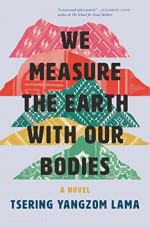|
This section contains 635 words (approx. 2 pages at 400 words per page) |

|
We Measure the Earth With Our Bodies Summary & Study Guide Description
We Measure the Earth With Our Bodies Summary & Study Guide includes comprehensive information and analysis to help you understand the book. This study guide contains the following sections:
This detailed literature summary also contains Quotes and a Free Quiz on We Measure the Earth With Our Bodies by Tsering Yangzom Lama.
The following version of this book was used to create the guide: Lama, Tsering Yangzom. We Measure the Earth with Our Bodies. Bloomsbury Publishing Inc., 2022.
Tsering Yangzom Lama's novel We Measure the Earth with Our Bodies spans over 50 years, tracing the lives of sisters Lhamo and Tenkyi, Lhamo's daughter Dolma, and Lhamo's lover Samphel. The novel is written from each of these four main characters' first person points of view and employs the past and present tenses. Alternately set in Tibet, Nepal, and Canada, the novel toys with traditional notions of structure and form. The following summary relies upon the past tense, and a linear mode of explanation.
In 1960, sisters Lhamo and Tenkyi were living in a village at the border of Western Tibet and Nepal when the People's Liberation Army invaded their land. Afraid that the soldiers, or Gyami, would destroy their way of life, Lhamo's and Tenkyi's family and community fled to Nepal. Over the following two years, they traveled from one Nepali region to another, eventually establishing a refugee camp in Pokhara, Nepal in 1962.
Now orphaned, Lhamo and Tenkyi relied upon their uncle, Ashang Migmar, for care and protection. When Lhamo learned that Ashang planned to send Tenkyi to live with their aunt, Shumo Yangsel, in Kathmandu, she panicked. She had promised her mother she would protect Tenkyi no matter what.
One day, a family friend named Po Dhondup arrived at the camp with his nephew, Samphel. Lhamo and Samphel became close almost at once. After Po Dhondup's unexpected death, Lhamo, Samphel, and Ashang snuck his body to Kathmandu for proper funeral rites. While there, Ashang decided to leave Lhamo with Shumo. In order to return home to her sister, Lhamo feigned madness.
By 1973, Lhamo had lost touch with Samphel. Despite their separation as children, she thought about him often. When Tenkyi left the camp for school in Delhi, Lhamo became desperate to create a life for herself, too. She decided to marry a man named Tashi although she was still in love with Samphel. On her wedding night, she snuck into Ashang's tent and stole the camp's precious Nameless Saint statue. She believed Samphel was the statue's rightful owner, and wanted to return it to him someday.
In 1984, Lhamo was shocked when Samphel resurfaced in Pokhara. Though she was still married to Tashi, Tashi was rarely home. He was constantly drunk and unfaithful to Lhamo. Lhamo and Samphel spent a single day together, reminiscing and reigniting their old affections. After Lhamo gave Samphel the Saint, the lovers had sex.
Years later, Samphel discovered that he had a seven-year-old daughter with Lhamo. He tried to become a part of their lives, but Tenkyi intervened. She told Samphel if he wanted to help them, he should fund his daughter Dolma's education.
By 2012, Dolma was living in Toronto, Canada with Tenkyi. Though she loved her aunt, she was desperate to make a life of own. She constantly felt trapped and displaced. She had lived in Toronto for some time, but the city still did not feel like home. One evening while Dolma was at a party, an art collector showed her her newest acquisition: the statue of an emaciated man. Dolma immediately recognized the statue as the Nameless Saint from her family's stories. She stole the Saint and gave him to Tenkyi, determined to return him to her people.
Immediately after learning that Lhamo had had an accident, Dolma returned to Nepal. Samphel received the same news and ventured to Pokhara, arriving shortly before Lhamo's death. Following Lhamo's funeral, Samphel and Dolma transported Lhamo's ashes to the Tibetan border. The journey changed Dolma's perspective. She realized the truth of who she was and what she wanted, feeling a sense of home and belonging for the first time in her life.
Read more from the Study Guide
|
This section contains 635 words (approx. 2 pages at 400 words per page) |

|



